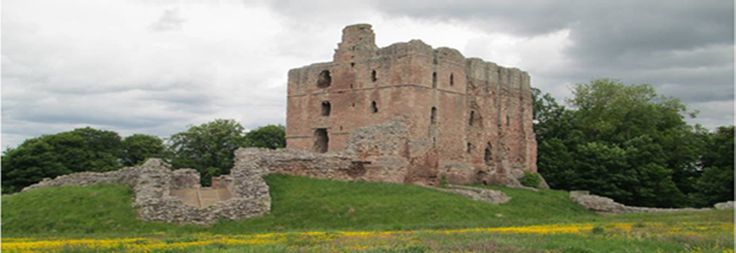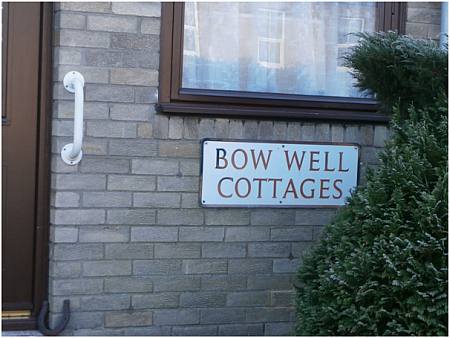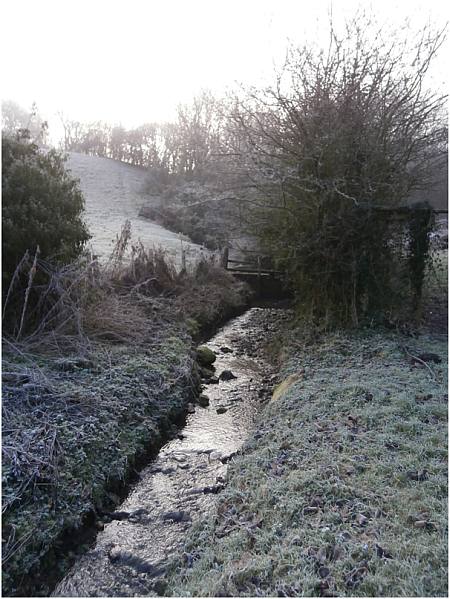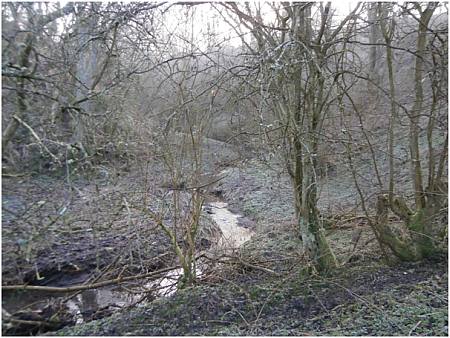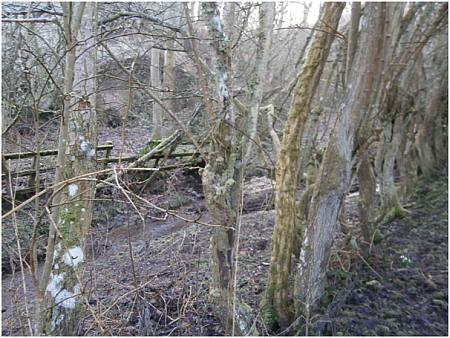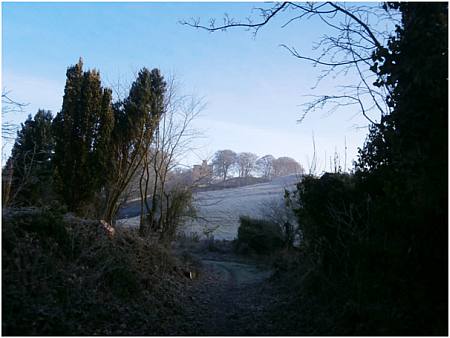In 1872, Parliament passed The Public Health Act establishing Urban and Rural Sanitary Authorities (USA and RSA), whose duty it was to provide clean water, dispose of all sewage and refuse, and appoint a legally qualified medical practitioner as medical officer as well as an inspector of nuisances. The borders of these authorities coincided with those of the poor law unions. The USA covered Berwick, Tweedmouth and Spittal, and the RSA the rest of the union. The RSA was run as a sub-committee under the board of guardians.
As water supply and disposal of sewerage in Norham had seemed to be a problem for some time the RSA decided in the beginning of 1880 to consider ways of improving the situation. This project was centred around the Bow Well, in the middle of Castle Street, the main street (the present day Bow Well Cottages testify to where the well was). The Local Government Board were contacted and informed about the plan, and Mr Joseph Batty of Widdrington was employed as surveyor. He quickly drew up a plan which was just as quickly dismissed by the Board. While he was working on his amended plan, the RSA asked Mr Fredrick P Wilson, architect and surveyor, Bondgate, Alnwick, for a detailed account of his services and expenses in relation to water supply in Norham, and was subsequently sent a cheque for £15. It is not clear why his service was discontinued and Mr Batty taken on instead, but we do know that Mr Batty had been used by the RSA in other cases.
An amended plan was forwarded to the Local Government Board, and in an entry in GBR82/185 on 29 December 1880 we learn in a letter to Mr Batty that the Local Government Board were favourably inclined towards the amended plan but raised the question whether there was sufficient water in the Norham Mill Burn to work a water wheel. So here we learn by inference – as the plan no longer exists – that the intention was to somehow connect the Bow Well with the Mill Burn situated at the edge of the village at the bottom of the castle, and build a water wheel on the burn.
The Local Government Board sanctioned the plan and the next step was how to finance the project. This was to be done by applying to the Local Government Board for their sanction of a loan of £800 from the Public Works Loan Board, even though this resolution was only passed by a majority of six to five, and as is often the case, even before work was started it is changed and a plan of underground sewers was dropped.
In January 1881 the RSA wrote Mr Batty in reply to his letter in which he requested information of the possibility of purchasing a piece of land for a planned reservoir. So we can now gather that the plan was to connect the Bow Well with pipes to the Mill Burn and secure a sufficient supply of water by building a reservoir and a water wheel. The land in question was owned by Edward Liddle of Morris Hall, situated across from the castle, so a letter was sent off in April requesting to use the burn as it ran through his property and to buy a piece of land not exceeding a quarter of an acre. In August Mr Batty was asked to supply further specifications for the project, repeated a few weeks later, urging him to submit the specifications so that the RSA could start obtaining tenders. In the meantime the RSA seemed to have changed their mind as they now proposed that the scheme for underground sewers for the village should be revived and carried out in connection with the water supply scheme, and Mr Batty was requested to furnish them with a plan for this.
Another hold-up occurred when no reply had been received regarding the purchase of land more than seven months after the request had been made. Not until the beginning of the new year was a reply received from Mr Liddle’s solicitors, Messrs Dees & Thompson, Newcastle, quoting a price of £200 per acre. The RSA found this too high and asked the solicitors to communicate this to Mr Liddle. Whether Mr Liddle changed his price we do not know, we only know that in a letter dated 21 March 1882 they accepted the offer made in a letter from Mr Liddle of 6 March 1882. It now appeared that the exact location of the piece of land agreed to be bought from Mr Liddle was not clearly indicated in Mr Batty’s plan, and he was consequently asked to appear in person in Norham so that the land could be identified correctly. Altogether there seem to have been a steady stream of correspondence from Mr Batty with amended plans and new estimates.
Finally during the summer and autumn of 1882 things seemed to be shaping up. The loan of £800 had been obtained upon the security of the rates of the township of Norham and repayable with interest in 30 years, and in the middle of September a public inquiry was announced to be held with Mr Batty in attendance to answer questions about the project.
On October 1882 the RSA wrote to Mr Batty asking him to make arrangements for proceeding with the construction of the works of the Bow Well water supply as per approved plan and estimates. Land rights had been purchased and an advance of the loan obtained by them would be paid in a few days.
Yet again the sewage scheme was deferred until the water works had been finished, based on a report from the Inspector of Nuisances. As a temporary measure a person willing to regularly clean the sewers would be appointed.
Some people saw business opportunities in connection with the water supply project and in March 1883 the RSA wrote to Mr Thomas Thompson, ironmonger, Berwick, in reply to his letter requesting permission to conduct water pipes from the new main into certain dwelling houses, that they would consider his request at their next meeting, at which it was decided that nothing should be done until the works were completed and the water pressure ascertained.
Apparently the project was finished in the middle of May 1883 when Messrs George Reuben Lumsden and William Allan inspected the works on behalf of the RSA and found them satisfactory, but just to be sure the Guardians decided to examine them as well in connection with their annual examination of out-door poor on 31 May.
On 11 July 1883 the RSA wrote the Local Government Board that the works of water supply for the village of Norham had been in operation since the beginning of May, and that Mr John Robson, joiner, had been appointed caretaker of the water works at an annual salary of £2 10s. They asked for the Board’s sanction of this, which was apparently given after a request as to the exact nature of the job had been satisfactorily explained to them. Mr Robson did not last very long in the job as he resigned in December, and was succeeded by Mr James Davidson who managed to secure an increase in the annual salary of 10 shillings.
The unusual thing happened that the total cost of the scheme only came to £700, which meant that the last £100 of the loan obtained could be cancelled, and the annual repayment reduced accordingly.
The Berwick ironmonger, Mr Thompson, apparently was not prepared to take no for an answer. In July he repeated his application to be allowed, on behalf of certain householders in Norham, to lay water supply pipes into their houses. The RSA turned the application down saying that they wanted to wait until the dry season was over to ascertain that there was a sufficient supply of water. We do not know what the outcome of the question of sufficient supply of water, but about a year later the RSA replied to a letter from John Cresswell, County Architect, Moot Hall, Newcastle, that the question of conducting water into private houses would depend on making sure that the water supply was sufficient to cope with this. It is tempting to think that Mr Thompson might have done a bit of lobbying.
Just as things seemed to be going smoothly somebody threw not a spanner but a stone into the works. In October 1884 the RSA sent a letter to Thomas Rule, Assistant Overseer, Norham, instructing him to proceed to collect the special rate to cover legal expenses in connection with the stoppage of water supply to Norham. The same day the RSA sent off a letter to the Local Government Board reporting that the deficiencies in the water supply to Norham was being caused by the wilful placing of a stone and a quantity of sods at the mouth of a pipe which passed through the estate of Mr H Young-Jamieson, situated at Grievestead. As the RSA had obtained a right to take sufficient water from the Mill Burn to drive the water wheel, steps would be taken for proceedings in the High Court of Justices against Mr Young-Jamieson. Any costs in connection with this should be paid by the township of Norham, which seems somewhat difficult to justify.
On 30 January 1885, the Berwick Advertiser reported that the case “Guardians of Berwick Union v Jamieson” had been heard in the Chancery Division before Vice-chancellor James Bacon on 23 January 1885, in which the plaintiff sought to restrain the defendant from obstructing or diverting water from the Mill Burn.
The outcome of the trial, which was reported in a letter sent by the RSA to the Local Government Board in March 1885, was that the defendant, or anybody working for him, would be perpetually restrained from obstructing or diverting the water in question. However, each part should pay their own costs, which amounted to £240 10s 5d to be paid by the RSA, money they did not have. They therefore applied to the Local Government Board to be allowed to borrow £200 from the Public Loan Board, to be repaid in half-yearly instalments and the expiry date to coincide with the existing loan.
The Local Government Board did not consent to this and consequently the RSA sent a letter to Thomas Rule in April 1885, telling him to levy the necessary rate at once as the money had to be paid within the current quarter. It is not difficult to imagine how this would have gone down with the rate payers in Norham, and in June the Overseers in Norham were sent a letter from the RSA saying that as the money had not been paid to the Treasurer of the RSA they would start legal proceedings without further notice.
The ratepayers in Norham, however, seem to have admitted defeat as reported in the Berwick Advertiser on 10 July 1885, where it was stated that the special rate had been signed, and even though nothing had yet been paid in, the threat of legal procedures seems to have faded.
It has not been possible to ascertain with any accuracy where the reservoir and waterwheel were situated on the Mill Burn. In a list of waterwheels in north-east England published on-line by the North East Mills Group has: “Norham – ‘water wheel’ – grid ref. NT907458 – river or stream not known neither is the first date nor the use.” This is probably a reference to a waterwheel on the Rutchey Burn at Newbiggin Dene, which has been identified by the Mills Archive in Reading as being there in the 1860, and referred to as “waterwheel with a nearby mill pond”, so obviously not the right one. There are, however, on many of the maps published after the constriction of the Norham Mill Burn waterwheel clear indication of a sluice on the part of the burn which runs through the land which would have been owned by Mr Liddell, so it would be a reasonable guess that the waterwheel could have been situated about there.
Sources:
Correspondence books / Board of Guardians of Berwick-upon-Tweed Poor Law Union: GBR 82 & GBR 84 (Berwick Record Office).
Norham: Northumberland Extensive Urban Survey. Northumberland County Council and English Heritage, 2009.
Berwick Advertiser.
North-East Mills Group: website
Mills Archive (Reading): website

